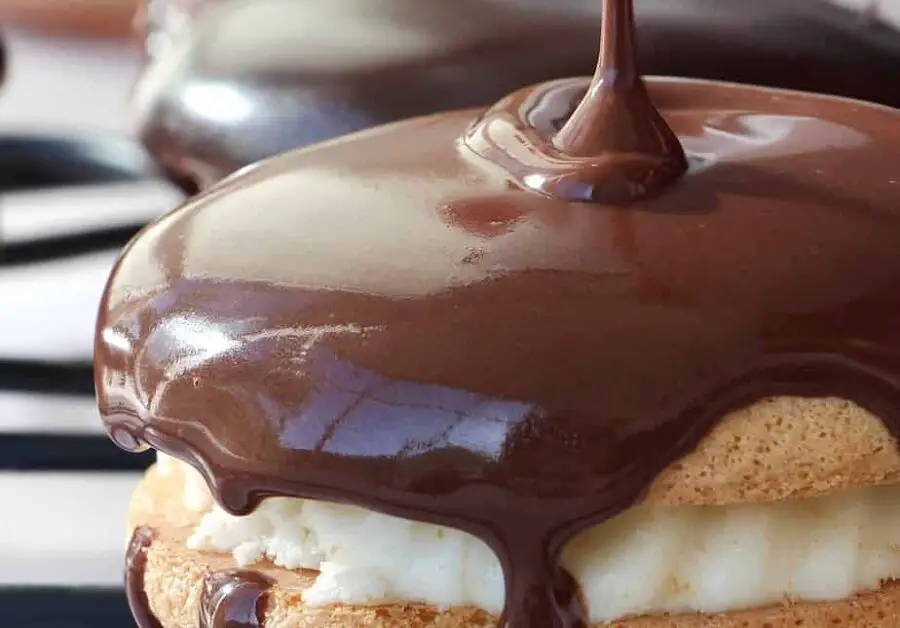Ganache and mousse are beloved by many, but for very different reasons.
This makes sense when you think about how each of them is normally used but unless you’ve already got some experience with how different they are, they can appear quite similar.
This is especially true when comparing chocolate ganache to chocolate mousse.
However, in reality, there are differences between ganache and mousse and not just of the chocolate variety.
The main difference between ganache and mousse is that ganache is exclusively used as a glaze, filling or dip in desserts whereas mousse can be used in sweet or savory dishes as an ingredient or eaten as a standalone food.
There are many other differences between these two staples of French cuisine and we’ll be taking an in-depth look at things like differences in how each originated, ways in which they’re used and much more.
So with those formalities out of the way, let’s get right into what sets ganache and mousse apart from each other.
Origin Differences
Both ganache and mousse trace their origins to the country of France.
Ganache has an interesting history in that it food historians believe it was eaten in a completely different manner than the ganache we know today.
Consumed as a chocolate truffle, early on it was also called crème ganache.
The man who is credited with its creation is known as Paul Siraudin, a confectioner from Paris who’s thought to have developed it in 1869.
Of course we all know how delicious ganache is, but the term itself has a certain flair, doesn’t it?
Well, if you agree, then it should come as no surprise that Mr. Siraudin borrowed the term from a hit Vaudeville comedy taking Paris by storm at the time entitled, “Les Ganache”.
It seems that prior to his career as a confectioner, Mr. Siraudin spent some of his earlier years as a playwright. As an homage to his prior life, Mr. Siraudin dedicated his new creation based on his passion for his former career.
While the origins of ganache are fairly well known, the same cannot be said of mousse.
The French term mousse translates to “foam”. The term foam is used to describe soft food that is aerated to have a light and fluffy structure.
Actually, mousse is a derivative of an earlier invention known as culinary foam which, besides mousse, can take other forms like meringue, whipped cream and more.
While culinary foams have experienced a bit of renaissance in modern cooking, the French have incorporated them for more than two hundred years, even predating the first appearance of mousse. In fact, a book written in the 18th century describes foam as one of the King’s favorite foods.
“Suppers at Court”, penned by Menon, specifically states that a blended (foam) drink made with eggs, water and chocolate was beloved by Louis XV.
It’s worth mentioning that the most popular style of mousse, chocolate mousse, is thought to have found its roots at the hands of another creative person. While ganache was the brainchild of a former playwright, chocolate mousse was the invention of one of France’s pre-eminent artists in the late 1800s.
Henri de Toulouse-Lautrec is said to have dreamed up “mayonnaise de chocolat”. While there’s no mayonnaise in it, the name speaks to the undeniable creaminess that makes mousse so irresistible.
| Feature | Ganache | Mousse |
|---|---|---|
| Origin | France | France |
| Creator | Paul Siraudin (1869) | Unknown (18th century) |
| Name inspiration | Les Ganache (Vaudeville comedy) | “Foam” (French term) |
| Popular style | Chocolate truffle | Chocolate mousse (invented by Henri de Toulouse-Lautrec) |
Ingredient and Preparation Differences
Part of what makes ganache so wonderful (aside from the taste) is the simplicity of its ingredients. At its core, ganache is an even parts blend of chocolate and cream.
To make it, the cream is first warmed prior to being poured over the chocolate. To achieve the desired smooth consistency, they’re stirred together repeatedly. Though not required, butter is often added to the mixture to give ganache the shiny glaze it is known for.
The nice thing about ganache is that it can be altered to suit tastes or the demands of a recipe depending on factors like the type of chocolate that’s used or the cream-to-chocolate ratio. Altering any of these can turn a ganache from a glaze to a filling or vice versa since they all have an impact on the consistency of the ganache.
A simple example of this is that when making a glaze, the cream-to-chocolate ratio is one-to-one. However, to make truffles, a thicker ganache is required so the ration of cream-to-chocolate shifts from equal to two parts chocolate and one part cream.
Without chocolate, you simply cannot have a ganache and when it comes to types of chocolate used in ganache, the three most common are milk, dark and white.
So while it’s clear that ganache shines when used in desserts and while that’s definitely true with mousse, it’s also equally well-suited for savory dishes and recipes.
In addition to the different uses, the final form mousse takes is also quite different from ganache. Where ganache is thick and spreadable, mousse is a dense foam that is most often served chilled.
Mousse is made by beating whipped cream, whipped egg whites (or both) until an airy texture is achieved. From there, other ingredients may be added depending on whether the mousse is sweet or savory.
Unlike ganache, mousse is stabilized with ingredients like gelatin that help it to hold its structure. This structured aspect of mousse enables it to be served in many ways. Mousse can be eaten molded or not and used as an ingredient in the form of a filling or spread.
While the use of ganache is limited to sweets, there are almost as many types of mousse as there are ways to use it!
| Ganache | Mousse | |
|---|---|---|
| Ingredients | Chocolate and cream, optional butter | Whipped cream, whipped egg whites, optional gelatin |
| Preparation | Cream is warmed and poured over chocolate, stirring repeatedly. Butter may be added for a shiny glaze. | Whipped cream and/or egg whites are beaten until an airy texture is achieved. Additional ingredients may be added for flavor. |
| Consistency | Thick and spreadable | Dense foam, usually served chilled |
| Types of chocolate used | Milk, dark, white | N/A |
| Uses | Desserts, savory dishes | Desserts and other uses, can be molded and used as a filling or spread |
| Stability | Not stabilized | Stabilized with ingredients like gelatin to hold structure |
Taste and Mouthfeel Differences
If you’ve never tasted ganache before, a good way to describe is to imagine eating a chocolate truffle.
Ganache is thick, creamy and depending on the type and amount of chocolate you’re using, oh so very chocolaty!
In general, the darker the chocolate, the less sweet the ganache. So, for milk (or white) chocolate ganache, you should expect it to be sweeter.
For many, the defining quality of mousse is its decadent, yet airy smoothness – there’s really nothing like it.
If you’ve never had it before, the closest possible taste and mouthfeel it resembles is probably pudding. However, unlike pudding, mousse is far creamier and more dense than anything you’d find in an ordinary pudding.
| Feature | Ganache | Mousse |
|---|---|---|
| Texture | Thick and creamy | Decadent, yet airy smoothness |
| Chocolate content | Depends on the type and amount of chocolate used (darker chocolate = less sweet) | Depends on ingredients |
| Sweetness | Less sweet for dark chocolate, sweeter for milk or white chocolate ganache | Depends on ingredients |
| Similar to | Chocolate truffle | Pudding (but creamier and more dense than ordinary pudding) |

Hiya! I’m Kimberly, a contributing writer here at Miss Buttercup. I was born and raised in the UP, Michigan’s Upper Peninsula for those who don’t know, the land of beautiful, beach-filled sunny summer days and bone-chilling long winters. Growing up there made me appreciate all the little things about life, especially the way a delicious meal can bring people closer together. I try and put that same feeling into each article I write and I hope it comes across that way!

